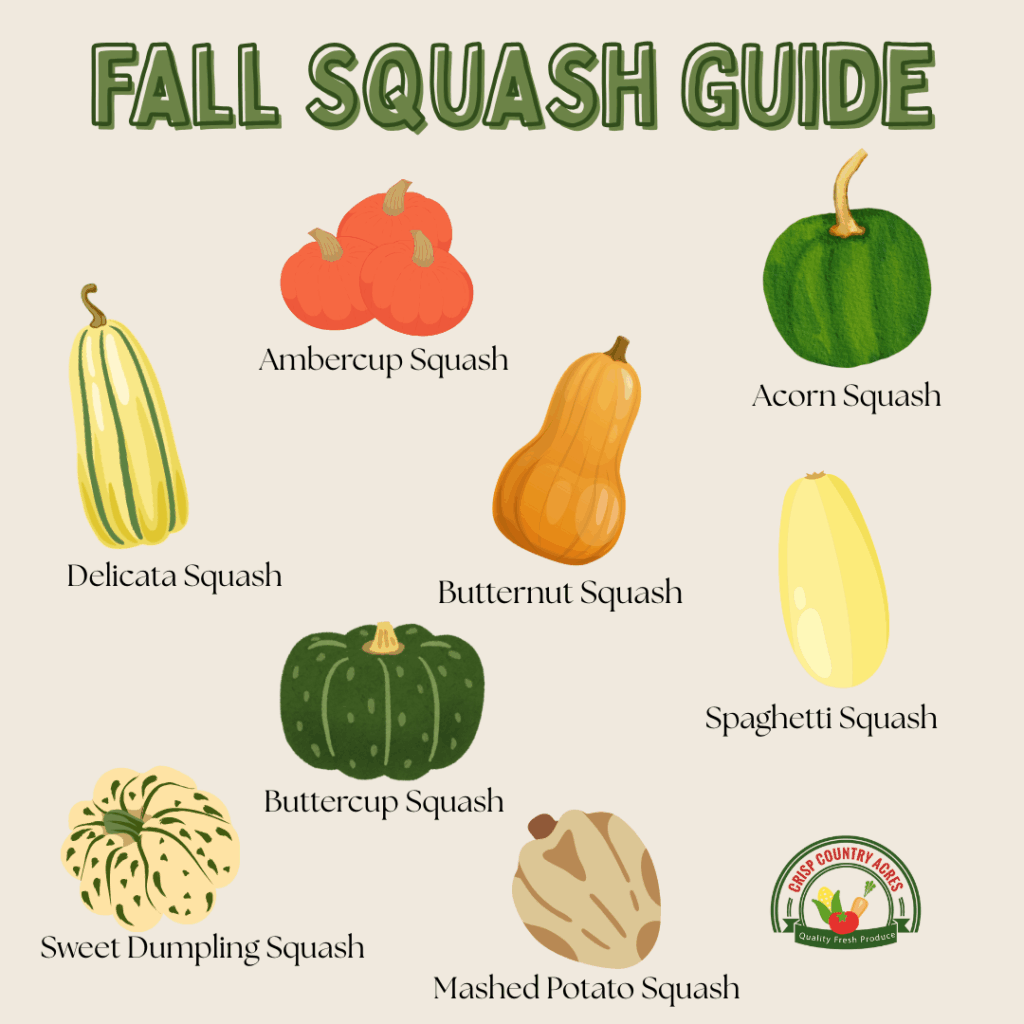Fall is here, and that means it’s time to embrace all the wonderful winter squashes that are now in season! I’ve put together this comprehensive guide to help you make the most of the seven varieties you have available.
Each one has its own unique flavor profile and ideal cooking methods, so you can discover new favorites and cook with confidence.
Whether you’re looking for something sweet and creamy for soup, a healthy pasta alternative, or a new side dish to impress your dinner guests, this guide has you covered.
Let’s dive into the delicious world of fall squashes!
Butternut Squash
Taste & Texture: Sweet, nutty flavor with a smooth, creamy texture when cooked. The flesh is bright orange and dense.
What It’s Like: Think of it as the “sweet potato” of squashes – rich, velvety, and naturally sweet with earthy undertones.
Best Cooking Methods:
- Roasting: Cut in half lengthwise, scoop out seeds, roast cut-side down at 400°F for 45-60 minutes
- Soup: Perfect for creamy butternut squash soup – roast first, then puree with broth
- Cubing: Peel and cube for roasted vegetables, risottos, or grain bowls
Buttercup Squash
Taste & Texture: Sweet and creamy with a slightly drier texture than butternut. Orange flesh with a rich, almost custard-like consistency.
What It’s Like: Similar sweetness to butternut but with a more concentrated, less watery texture – like a cross between sweet potato and pumpkin.
Best Cooking Methods:
- Stuffing: Cut off top, scoop out seeds, stuff with rice, nuts, and herbs
- Roasting: Cut into wedges, roast at 425°F for 30-40 minutes
- Mashing: Steam or roast, then mash as a side dish with butter and herbs
Ambercup Squash
Taste & Texture: Exceptionally sweet with dense, fine-grained flesh. Deep orange color with a smooth, creamy texture.
What It’s Like: The sweetest of the winter squashes – almost dessert-like with honey and maple notes.
Best Cooking Methods:
- Roasting whole: Pierce skin, roast at 350°F for 60-90 minutes until tender
- Baking: Cut into rings, remove seeds, bake with a drizzle of maple syrup
- Puree: Perfect for pies, muffins, and other baked goods
Spaghetti Squash
Taste & Texture: Mild, slightly sweet flavor with a unique stringy texture that separates into spaghetti-like strands.
What It’s Like: Think of it as nature’s pasta – neutral flavor that takes on whatever seasonings you add, with a satisfying, noodle-like texture.
Best Cooking Methods:
- Classic method: Cut in half lengthwise, scoop out seeds, roast cut-side down at 400°F for 40-50 minutes
- Microwave: Pierce whole squash, microwave 12-15 minutes, turning halfway through
- Use as pasta substitute: Scrape out strands with a fork, toss with marinara, pesto, or butter and herbs
Delicata Squash
Taste & Texture: Sweet and creamy with hints of corn and sweet potato. Tender, edible skin when cooked.
What It’s Like: The most convenient winter squash – no peeling required! Sweet like butternut but with a more delicate, less dense texture.
Best Cooking Methods:
- Roasted rings: Slice into half-moons, remove seeds, roast at 425°F for 20-25 minutes
- Stuffed: Cut in half lengthwise, stuff with quinoa, cranberries, and nuts
- Pan-fried: Slice thin and sauté as a side dish
Sweet Dumpling Squash
Taste & Texture: Very sweet with dense, smooth flesh. Small size makes them perfect for individual servings.
What It’s Like: Like eating a natural dessert – incredibly sweet with notes of honey and brown sugar. Dense like a sweet potato but sweeter.
Best Cooking Methods:
- Whole roasted: Pierce skin, roast at 350°F for 45-60 minutes
- Stuffed individual portions: Cut off top, scoop out seeds, stuff with wild rice mixture
- Halved and baked: Cut in half, scoop out seeds, bake with butter and cinnamon
Mashed Potato Squash (NEW this year!)
Taste & Texture: Mild, slightly sweet flavor with a dry, fluffy texture that’s remarkably similar to mashed potatoes.
What It’s Like: The name says it all – when cooked and mashed, it has the exact consistency of fluffy mashed potatoes but with a subtle sweet flavor.
Best Cooking Methods:
- Mashed: Steam or roast until tender, then mash with butter, salt, and pepper
- Roasted wedges: Cut into wedges, roast at 400°F for 35-45 minutes
- Soup base: Use as a creamy soup base – naturally thick without cream
General Cooking Tips
Storage: All winter squashes keep well in a cool, dry place for 2-6 months.
Prep shortcuts: For hard-to-cut squashes, pierce and microwave for 2-3 minutes to soften slightly before cutting.
Roasting basics: Most squashes benefit from a drizzle of olive oil, salt, and pepper before roasting.
Seed bonus: Don’t throw away the seeds! Clean, season, and roast them at 300°F for 20-30 minutes for a healthy snack.

